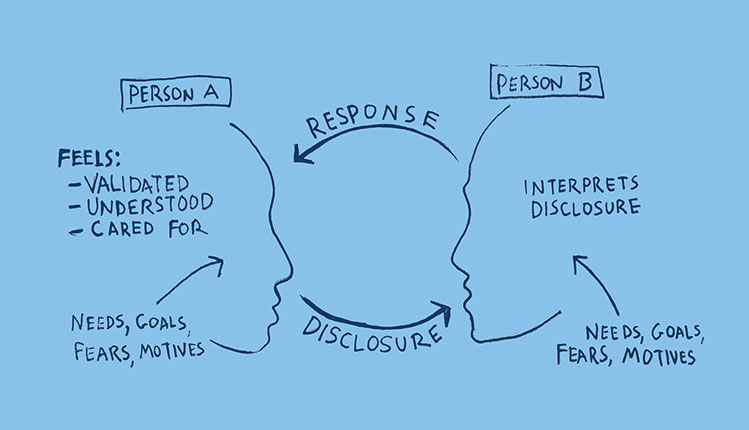
WHAT IS MOST important is to respond to your Other in a way that allows them to feel as if their story and feelings have been understood, that you accept and value what you have understood, and that you care for them as a person. Such responses are the cement and nails that bind your Other’s story and feelings to the structure of your bridge. No deep moment of human connection is complete until this understanding, validation, and care have been felt.
---------
In fact, this is how relationship scientists describe the process of building the bridge between Self and Other:
1. Person A shares something vulnerable with Person B about their feelings and story, this 'disclosure' is inspired by their unique motivations, needs, goals, and fears in that moment.
2. Person B interprets Person A's disclosure through the lens of their own story and feelings, which are also influenced by their own motivations, needs, goals, and fears in that moment; and then Person B responds.
3. Person A interprets Person B's response through the lens of their story and feelings.
4. If Person A feels understood, validated, and cared for by Person B's response then a successful moment of human connection has occurred.
---------
So beyond avoiding responses that eclipse connection, how do you respond in a way that shows understanding, validation and care?
Understanding – While simply telling our Others that we ‘get’ what they are saying may be enough, we can also speak back to them what we hear, paraphrasing the gist of their statement, asking if our interpretation is correct.
Validation – We can help our Others toward feeling validated by pointing toward their strengths, demonstrating that we believe in them and accept them for who they are, and acknowledging that the emotions and story that they have expressed is their reality.
Care – We all express care in different ways. Luckily an act of deep and generous listening has likely already expressed to our Other that we care for them. You can directly tell them in your own words, in gestures, in touch, in whichever way feels most natural, how much they matter to you.
Beyond this, the challenge of responding is to do so in a way that clears space for your Other to open up rather than shut down. Ask your Other to tell you more, to describe what happened next, how the experience felt. In a time of struggle, you can share a story that shows that you have been through the same or similar hardship. Some folks need us to reach in with questions to prompt them to open up, others will flood us with more information than we can handle. It takes time to get to know the unique vibrations of our relationship, to fine-tune our precise ways of relating. And, of course, there will be much bridge-shaking in any relationship. Yet, the better we are connected and the more trust that’s supporting our bridge, the more space we will have to knock each other over with an unconscious boast or a piece of unwanted advice.